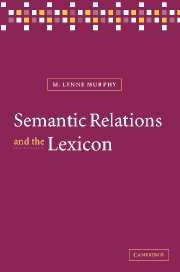Book contents
- Frontmatter
- Contents
- Acknowledgments
- Symbols and typographical conventions
- Part I Paradigmatic relations, generally
- Part II Paradigmatic relations, specifically
- 4 Synonymy and similarity
- 5 Antonymy and contrast
- 6 Hyponymy, meronymy, and other relations
- 7 Lexicon and metalexicon: implications and explorations
- Appendix: Relation elements
- Notes
- References
- Index
6 - Hyponymy, meronymy, and other relations
Published online by Cambridge University Press: 22 September 2009
- Frontmatter
- Contents
- Acknowledgments
- Symbols and typographical conventions
- Part I Paradigmatic relations, generally
- Part II Paradigmatic relations, specifically
- 4 Synonymy and similarity
- 5 Antonymy and contrast
- 6 Hyponymy, meronymy, and other relations
- 7 Lexicon and metalexicon: implications and explorations
- Appendix: Relation elements
- Notes
- References
- Index
Summary
The word butterfly is not a real butterfly. There is the word and there is the butterfly. If you confuse these two items people have the right to laugh at you.
Leonard Cohen, “How to Speak Poetry” (1978)The relations in this chapter are allotted fewer pages than synonymy and antonymy because they have only a tenuous claim to the label lexical relation. While inclusion and part-whole relations in particular are acknowledged in lexical semantics texts, they are rarely relations among words and almost always relations among concepts or things. Since approaches to meaning and semantic relations differ in the amount and nature of semantic content represented in the lexicon, relations like hyponymy and meronymy have varying levels of relevance to different theorists. The assumption here, however, is that the lexicon includes no paradigmatic relational information. In spite of this, synonymy and antonymy are lexicologically interesting as metalexical relations – relations among word-concepts. There is little evidence, however, that hyponymy, meronymy, or other semantic relations are relations among word-concepts rather than relations among the things (or concepts) that those words denote. This chapter, then, concerns why these relations are sometimes treated as (intra)lexical relations and demonstrates that they usually are not relations among words. Relation by Contrast (RC) is still relevant to these relations, since it can contrast any concepts, not just lexical concepts, but this book is concerned with its lexical-semantic applications, and the relations in this chapter are less clearly lexical-semantic relations.
- Type
- Chapter
- Information
- Semantic Relations and the LexiconAntonymy, Synonymy and other Paradigms, pp. 216 - 236Publisher: Cambridge University PressPrint publication year: 2003



